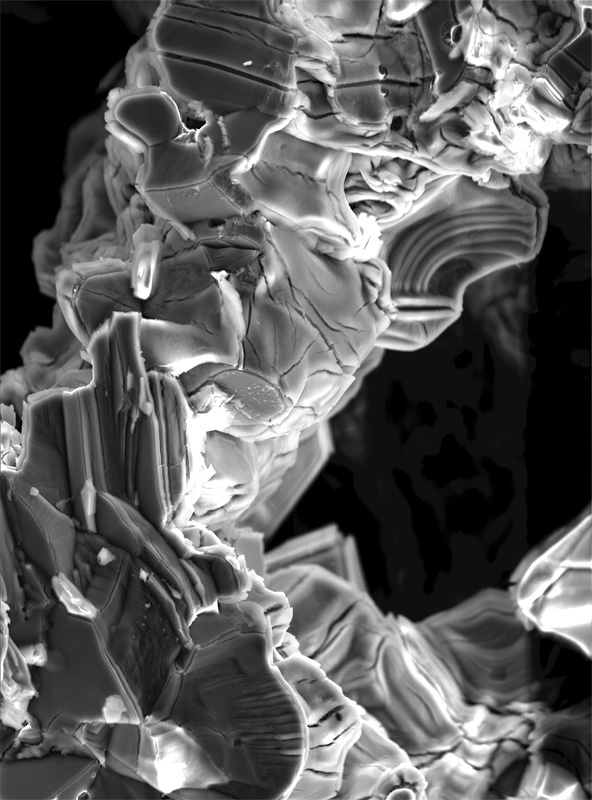

Title: NanoArt Abstractionists Painting By Digital Artist Cris Orfescu
Shipping: $25.00
Artist: N/A
Period: Contemporary
History: N/A
Origin: N/A
Condition: Excellent
Item Date: 2009
Item ID: 2032
Edition size: 10. Cris Orfescu is a self-taught artist born in Bucharest, Romania who lives and works in Los Angeles since 1991. He is experimenting with different media and art forms for over 40 years: NanoArt, digital art, murals, acrylic and oil painting, mixed media, faux painting, trompe l’oeil, collage, graphics, animation, web design, logo design, and a backdrop for a TV show. For more than 25 years he is experimenting and perfecting a new art form, NANOART, which reflects the transition from Science to Art through Technology. Orfescu was showing internationally his awarded works in USA, Italy, France, Finland, Korea, UK, Ireland, Spain, Germany, Colombia, Greece in 15 solo and 45 group shows. His art was commissioned by public and private parties. "Nanographite Psychedelic Mushrooms" is a nanosculpture created by drying a drop of colloidal graphite (graphite nanoparticles in a liquid suspension) in Liquid Nitrogen at 196 degrees Celsius bellow zero. The structure was visualized with a Scanning Electron Microscope. The image was captured in a computer and printed by the artist on luster ultra premium photo paper with Epson archival inks specially formulated to last for a long time. All prints are hand-signed on the left-bottom corner on the front side of the print and hand-signed and numbered by the artist on the back side of the print. Also, each print has the artist's fingerprint on the back side. The prints will be shipped rolled in a sturdy tube to prevent damages. "I bring the small world in front of my audience through high resolution electron microscope scans of natural micro or nanostructures and sculptures I create at micro or nano scale by physical or/and chemical processing. I take further steps by manipulating the digitized electron scans and printing them with long-lasting inks on fine art paper (giclee prints). This way, the scientific images become artworks and could be showcased for a large audience to educate the public with creative images that are appealing and acceptable. My artistic process starts in a laboratory where I create different structures through the means of physics and chemistry. I called these structures, Nanosculptures. Basically, I make sculptures at molecular level. For my artworks, I also use natural structures of different materials, and I called these Nanolandscapes. The next steps of my process are structure visualization and image capture. To accomplish these steps, I am using a Scanning Electron Microscope (SEM). Scanning electron microscopy is a method for high-resolution imaging of surfaces. The SEM uses electrons for imaging, much as a Light Optical Microscope (LOM) uses visible light. Conventional light microscopes and photographic cameras, use a series of glass lenses to bend light waves and create a magnified image. The SEM uses electromagnetic lenses to bend the electron beams and create the magnified images which are rendered black and white, because of the luck of light (no light, no colors). The advantages of the SEM over the LOM include greater magnification (2000000 times in SEM vs. 1000 times in LOM) and a much greater depth of field. Imaging is typically obtained using secondary electrons (SE) for the best resolution of fine surface topographical features. The image resolution for an ideal sample is in the nanometers range (1 nanometer is about 80,000 smaller than the human hair diameter). After visualization, the image is captured in a computer and enhanced. The final step of my artistic process is printing. I print my works on canvas or fine art paper with long-lasting inks (archival inks) using Epson process. Epson ink technology produces archival prints with amazing gloss level and scratch resistance.
http://en.wikipedia.org/wiki/Nanoart
NanoArt is a new art discipline at the art-science-technology intersections. It features nanolandscapes (molecular and atomic landscapes which are natural structures of matter at molecular and atomic scales) and nanosculptures (structures created by scientists and artists by manipulating matter at molecular and atomic scales using chemical and physical processes). These structures are visualized with research tools like scanning electron microscopes and atomic force microscopes and their scientific images are captured and further processed by using different artistic techniques to convert them into artworks showcased for large audiences. NanoArt should not be confused with Microphotography which is performed using an optical microscope with a photographic camera attached to it and renders flat images at low magnification. The depth and three dimensions achieved in NanoArt sets this imaging process apart from Photography where images are created by photons (particles of light) rather than by electrons (electrically charged particles). The electrons penetrate deeper inside the structure creating images with more depth, more natural 3D-look than the photographic images.